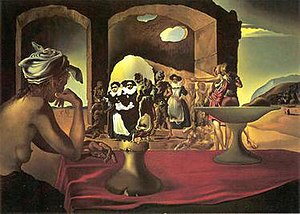Slave_Market_with_the_Disappearing_Bust_of_Voltaire
Slave Market with the Disappearing Bust of Voltaire
Painting by Salvador Dalí
Slave Market with the Disappearing Bust of Voltaire (1940) is a painting by Spanish Surrealist Salvador Dalí. The painting depicts a slave market, while a woman at a booth watches the people. A variety of people seem to make up the face of Voltaire, while the face seems to be positioned on an object to form a bust of Voltaire. Voltaire was a French writer and philosopher known for his opposition to slavery.
This article needs additional citations for verification. (January 2021) |
The painting was completed in 1940 in oil on canvas. Dalí describes his work on the painting "to make the abnormal look normal and the normal look abnormal."[1] He used a technique so called "double mage", where one form contains two or more images. In the painting, two women dressed in seventeenth-century costumes form the face of Jean-Antoine Houdon's bust of Voltaire.[2]
